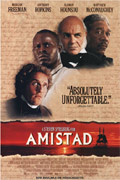You are here: Reports » Phase 1: media » Reviews » Amistad
Amistad
Year: 1997
Directed: Steven Spielberg
Production: Dreamworks

The film follows the events which occurred after the revolt by enslaved Africans onboard the slave ship Amistad. It draws heavily upon the W.A. Owens book, Black Mutiny: The Revolt on the Schooner Amistad. It describes the Africans capture, their enslavement, their purchase, the overthrow of their captors and the subsequent trials in America, where they won their freedom and eventual return to Africa. Featuring the notable actors, Morgan Freeman and Anthony Hopkins, the film has gained a prominent place in the filmic representation of the Atlantic slave trade.
The film succeeds on the basis of two core themes, suffering and survival. The way in which these two are represented mark the film as unique. The opening scenes of the enslaved Africans overrunning the Amistad, killing its crew and taking over sets the tone of the film, and the audience is never allowed to forget the image of the muscular African screaming as he thrusts his sword into one of his former captors. The enslaved Africans are not represented as supplicants: they have fought for their freedom. These images are coupled with representations of the Middle Passage which are often considered to be the most powerful aspect of the film. In the hold of the slave ship, the camera pans across the chained bodies of the enslaved. Sickness, brutality, mutilation and death are depicted in these scenes; blood is splattered across the deck of the ship as the visceral horrors of enslavement are brought to attention. Suffering and survival are thereby expressed with the film's evident attention to the human body. It is the human form which becomes the means by which the suffering of enslavement is portrayed, the strength of the enslaved is celebrated and the legality of enslavement debated. It is this expression of the corporeal which marks the film as innovative and which has won it so many accolades. The strong body, the body in pain and the body in law form a means of comparison and contrast. The muscular body which strikes against those who have imprisoned it is forcefully expressed. The suffering body on the slave ship serves as a graphic reminder of the pain inflicted onto others. The courtroom arguments that centre upon the ownership of the 'cargo' of the Amistad are resolved only when this 'cargo' is recognised as being human bodies.
This distinctive approach to the filmic representation of the Atlantic slave trade is also evident in the portrayal of African culture and identity. Sengbe, the lead member of the enslaved Africans, is shown as strong, knowledgeable and highly intelligent. Rather than turn the story of the Amistad into a celebration of the kindness and generosity of white abolitionists, Sengbe is shown to be the instigator and cause of the freedom which is eventually granted to the enslaved Africans. The complexities and diversity of 'African' culture are also highlighted, with the tribal divisions between those who were captured shown by differences between language, culture and beliefs. This difference of culture is also drawn attention to with the problems of communication between this group of Africans and American society. This difficulty is shown to be felt most keenly by those who were former slaves, who are now dislocated from their own African heritage. This struggle to comprehend one another can be contrasted with the final victory in the Supreme Court as understanding is revealed as the key by which injustice can be recognised. This message is not presented as too saccharine though, despite the film's status as a major Hollywood film. With major academics assisting with the project, including Henry Louis Gates, the film is well-filmed and well-researched. Its distinctiveness however is marked by the choice to focus on the human body to tell the story of the Amistad and through this the brutalities of the Atlantic slave trade.
